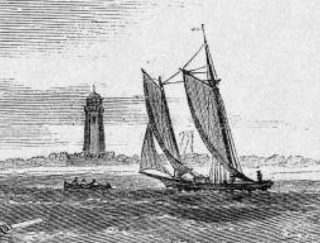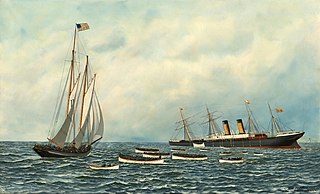
George W. Blunt, completed in 1856, was a schooner built in New York that operated as a New York Sandy Hook pilot boat designated Pilot Boat No. 11. The schooner was used to pilot vessels to and from the Port of New York and New Jersey. That schooner was sold to the United States Navy in 1861, renamed and commissioned as the USS G. W. Blunt (1856), serving in the South Atlantic Blockading Squadron in the South. A second schooner, also named George W. Blunt, was built in East Boston in 1861 and purchased to replace the first schooner as a pilot boat.

The Ellwood Walter, No. 7 was a 19th-century Sandy Hook pilot boat built in 1853 by Edward F. Williams at Greenpoint, Brooklyn to replace the pilot boat Yankee, which was lost in December 1852. The schooner was used to pilot vessels to and from the Port of New York. She was replaced by the Edmund Driggs, No. 7, in 1864.

The Columbia was a 19th-century pilot boat built C. & R. Poillon shipyard in 1879 for Sandy Hook and New York pilots that owned the Isaac Webb, which was lost off Quonochontaug Beach, Long Island in July 1879. She was run down by the Guion Line steamer SS Alaska in 1883. A second pilot-boat, also named Columbia, was built by Ambrose A. Martin at East Boston in 1894 that had a unique spoon bow and was extremely fast. She was thrown ashore in the great Portland Gale, and remained on the Sand Hills beach in Scituate, Massachusetts for over thirty years as a marine curiosity. The Louise No. 2 replaced the ill-fated Columbia.

The Richard K. Fox, first named Lillie, was a 19th-century pilot boat built in 1876 for Boston Pilots. She was designed by model by Dennison J. Lawlor. She was one of the most graceful and attractive of the Boston pilot-boats and represented a trend toward deep-bodied boats. She was later sold to the New York pilots and renamed Richard K. Fox in honor of the famous sportsman and publisher of the Police Gazette. In the age of steam, she was sold in 1896 to the Marine Hospital Service.

The Phantom was a 19th-century Sandy Hook pilot boat built in 1867 from the designs by Dennison J. Lawlor. The schooner was considered a model for her type with a reputation for being very fast. She helped rescue the passengers on the steamship SS Oregon when it sank in 1886. She was one of the pilot-boats that was lost in the Great Blizzard of 1888. The Phantom was replaced by the pilot-boat William H. Bateman.

James Funk was a 19th-century New York City pilot boat built in 1862 at Greenpoint, Brooklyn for a company of New York Pilots. She was built for speed. She was assigned the "Number 22," which was displayed on her mainsail. The James Funk was captured and burned by the Confederate raiding steamer CSS Tallahassee during the American Civil War. The Charlotte Webb was built in 1865 to take the place of the James Funk that was destroyed.

The Washington was a 19th-century Sandy Hook pilot boat built in 1845 by C. & R. Poillon for New York Pilots. She was rebuilt several times, the last with the sail number "22" painted on her mainsail. In 1884, she was sunk by the German steamship Roma, and then replaced by a new Washington.

The Francis Perkins, No. 13 was a 19th-century Sandy Hook pilot boat, built by Henry Steers in 1866 for a group of New York Pilots. She was considered one of the finest boats ever built. During a snow storm in 1887, the Perkins struck the steamship Aries and sank near the Barnegat shoals.

The Edward F. Williams was a 19th-century Sandy Hook pilot boat, built in 1863 at the Edward F. Williams shipyard in Greenpoint, Brooklyn for a group of New York Pilots. She survived the Great Blizzard of 1888. In the age of steam, the Williams was sold in 1896.

The Jesse Carll was a 19th-century pilot boat, built in 1885 by Jesse Carll at Northport, New York, for George H. Sisco. She was one of the largest vessels ever built in the Sandy Hook service. She was named in honor of Jesse Carll, a well-known Northport shipbuilder. In 1896, in the age of steam, the Ezra Nye, along with other pilot boats, were replaced with steamboats.

The James M. Waterbury was a 19th-century Sandy Hook pilot boat built in 1843, at Williamsburgh, Brooklyn for a group of New York Pilots. She helped on many of the rescues along the New York Harbor. One of last reports of the James M. Waterbury was in 1867 when seaman James Roach fell overboard and was drowned off Fire Island.
The Mary Ann, No. 13 was a 19th-century Sandy Hook pilot boat built for the New York pilots. She helped transport maritime pilots between inbound or outbound ships coming into the New York Harbor. In 1860, the Mary Ann, was one of only twenty-one pilot boats in the New York and New Jersey fleet. She went ashore outside Sandy Hook in 1863.

The Nettle was a 19th-century Sandy Hook pilot boat built in 1844 by S. Hall of East Boston, Massachusetts for the New York Pilots. She helped transport maritime pilots between inbound or outbound ships coming into the New York Harbor. In 1868, she found the wreck of the bark Henry Trowbridge, and towed her to Sandy Hook. The Nettle, sank in 1876 in the Pensacola Bay. The sunken wreck was removed in 1878 to improve the Pensacola harbor.

The Centennial was a 19th-century wood pilot boat built in 1876 by Robert Crosbie and designed by Boston designer Dennison J. Lawlor for New York and New Jersey pilots. She was one of the pilot-boats that survived the Great Blizzard of 1888. By 1898, in the age of steam, she was the last pilot boat left in the fleet; then sold in 1898 to a group in Montego Bay, Jamaica.

The Caprice was a 19th-century Sandy Hook pilot boat built in 1871 by Brown & Lovell in East Boston, Massachusetts for Peter McEnany and other New York pilots. In 1876, she was run down and sank, off Bay Ridge, Brooklyn, by the steamship New Orleans. She was raised and was one of the pilot boats that survived the Great Blizzard of 1888. The Caprice was last reported sailing off the coast of New York in 1891.

The David Carll was a 19th-century pilot boat, built in 1885 at the David Carll shipyard in City Island, New York. She was named in honor of David Carll, a well-known City Island shipbuilder. The David Carll was considered to be among the fastest schooners in the fleet. She was built to replace the Mary E. Fish that was run down and sank by the schooner Frank Harrington in 1885. She was one of the pilot boats that survived the Great Blizzard of 1888. The David Carll was lost at sea in 1893.

The Anthony B. Neilson was a 19th-century Sandy Hook pilot boat, built in 1854 by George Steers for a company of New York Sandy Hook pilots. She was considered to be the fastest boat in the piloting business. She helped transport New York City maritime pilots between inbound or outbound ships coming into the New York Harbor. She survived the Great Blizzard of 1888. In 1859, the Neilson was sold to a group of New Orleans pilots. The New York pilots then replaced the Neilson, with a new pilot boat, the John D. Jones.

The Mary E. Fish was a 19th-century Sandy Hook pilot boat, built at the Edward F. Williams shipyard of Greenpoint, Brooklyn in 1861 for Richard Brown and the New York Pilots. She was built to replace the Mary Taylor. The Fish was hit and sank by the schooner Frank Harrington in 1885 and replaced by the David Carll.
The Yankee was a 19th-century Sandy Hook pilot boat built by Holbrook & Adams of Boston in 1848. The schooner was sold to New York pilots and used to pilot vessels to and from the Port of New York. In 1852 the crew of the Yankee received silver medals from the Massachusetts Humane Society for rescuing the captain and mate of the schooner Reaper. The Yankee struck an old wreck and sank 35 miles east of Sandy Hook in 1852. The Ellwood Walter was built to replace her in 1853.
















